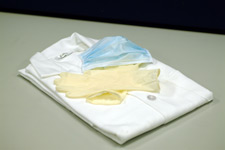Home | Glossary | Resources | Help | Contact Us | Course Map
Archival Notice
This is an archive page that is no longer being updated. It may contain outdated information and links may no longer function as originally intended.
Contamination
The prevention and detection of laboratory contamination, specifically the introduction of exogenous mtDNA into the testing process, is given special attention in mtDNA testing because of the natural abundance (high copy number) of mtDNA. Prevention methods include:
- Separation of pre- and post-PCR processing.
- Dedicated reagents for extraction and PCR.
- Ultraviolet light and bleach to destroy DNA on surfaces.
- Lab coats, gloves, face masks, and other disposables.
The most important detection tools are negative controls that accompany all samples through testing and should remain free of mtDNA.
Additional Online Courses
- What Every First Responding Officer Should Know About DNA Evidence
- Collecting DNA Evidence at Property Crime Scenes
- DNA – A Prosecutor’s Practice Notebook
- Crime Scene and DNA Basics
- Laboratory Safety Programs
- DNA Amplification
- Population Genetics and Statistics
- Non-STR DNA Markers: SNPs, Y-STRs, LCN and mtDNA
- Firearms Examiner Training
- Forensic DNA Education for Law Enforcement Decisionmakers
- What Every Investigator and Evidence Technician Should Know About DNA Evidence
- Principles of Forensic DNA for Officers of the Court
- Law 101: Legal Guide for the Forensic Expert
- Laboratory Orientation and Testing of Body Fluids and Tissues
- DNA Extraction and Quantitation
- STR Data Analysis and Interpretation
- Communication Skills, Report Writing, and Courtroom Testimony
- Español for Law Enforcement
- Amplified DNA Product Separation for Forensic Analysts


